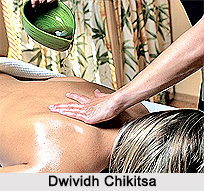 Dwividh Chikitsa suggests two types of treatment in Ayurveda. In Dwividh Chikitsa, the patient can be cured in two particular ways. In the first category of treatment, the patient has to undergo either Sheet upchaar (cold treatment) or Ushan upchaar (hot treatment). This treatment is done according to the cause and symptoms of the disease; if the disease is caused by cold then it is treated by hot treatment and vice versa.
Dwividh Chikitsa suggests two types of treatment in Ayurveda. In Dwividh Chikitsa, the patient can be cured in two particular ways. In the first category of treatment, the patient has to undergo either Sheet upchaar (cold treatment) or Ushan upchaar (hot treatment). This treatment is done according to the cause and symptoms of the disease; if the disease is caused by cold then it is treated by hot treatment and vice versa.
The second category of Dwividh Chikitsa, includes Santarpan chikitsa (increasing the strength and weight) and Aptarpan chikitsa (decreasing the strength and weight). Weak patient is cured by Santarpan (increasing the strength and weight) treatment so as to overcome his malnutrition. A heavy and a fat patient is given aptarpan (decreasing the strength and weight) treatment to reduce his overweight and obese body. The third category in Dwividh Chikitsa cures the patients by shodhan (cleaning the body of abnormalities especially the doshas) and Shaman (suppressing the abnormalities at that place only). When the patient is strong then he is given shodhan treatment or else he is given shaman treatment.
The fourth category of Dwividh Chikitsa comprises of Dravya bhoot chikitsa (materialistic treatment) and Adavya bhoot chikitsa (non-materialistic treatment). This treatment depends upon the condition of the patient. If the patient requires medicines then he is given so and this form is included under Dravya bhoot chikitsa (materialistic treatment) otherwise he will be given diet modification, which is included in Adravya bhoot chikitsa (non-materialistic treatment). The Dwividh Chikitsa is a very important form of Ayurveda, practised widely in India.
This article is a stub. You can enrich by adding more information to it. Send your Write Up to content@indianetzone.com




















